Small overlap front: driver-side
Rating applies to 2016-23 models
Tested vehicle: 2017 Toyota Tacoma SR5 Double Cab 2wd
The Toyota Tacoma Double Cab was re-engineered and restyled for the 2016 model year.
| Evaluation criteria | Rating |
|---|---|
| Structure and safety cage | |
| Driver injury measures | |
| Head/neck | |
| Chest | |
| Hip/thigh | |
| Lower leg/foot | |
| Driver restraints and dummy kinematics | |

Action shot taken during the driver-side small overlap frontal crash test.
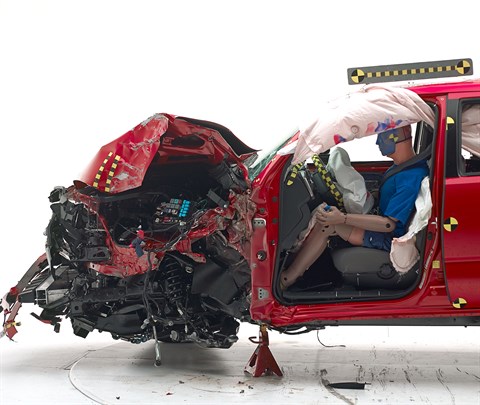
The dummy's position in relation to the door frame, steering wheel, and instrument panel after the crash test indicates that the driver's survival space was maintained well.

The frontal and side curtain airbags worked well together to keep the head from coming close to any stiff structure or outside objects that could cause injury.
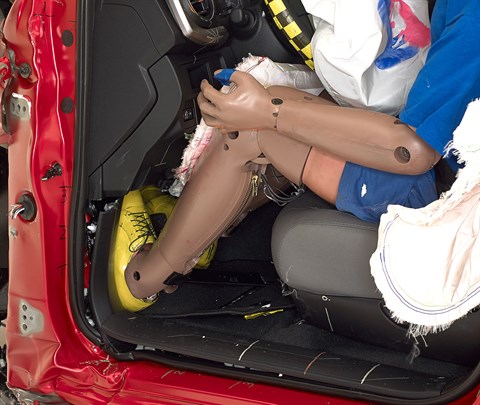
Although intrusion into the driver's space was minimal, forces on the dummy's left lower leg were high enough to indicate a moderate risk of injury.
Small overlap front: passenger-side
Rating applies to 2016-23 models
Tested vehicle: 2019 Toyota Tacoma SR5 Double Cab 2wd
The Toyota Tacoma Double Cab was re-engineered and restyled for the 2016 model year.
| Evaluation criteria | Rating |
|---|---|
| Overall evaluation | |
| Structure and safety cage | |
| Passenger injury measures | |
| Head/neck | |
| Chest | |
| Hip/thigh | |
| Lower leg/foot | |
|
Passenger restraints and dummy kinematics
The dummy’s movement was reasonably well controlled. The dummy’s head loaded the frontal airbag, which stayed in front of the dummy until rebound. The side curtain airbag deployed and has sufficient forward coverage to protect the head from contact with typical side structure and outside objects. The side torso airbag also deployed. However, the grab handle on the A-pillar protrudes so far into the path of the dummy's head that the rear of the head hit it. | |
| Driver injury measures | |
| Head/neck | |
| Chest | |
| Hip/thigh | |
| Lower leg/foot | |
| Driver restraints and dummy kinematics | |

Action shot taken during the passenger-side small overlap frontal crash test.
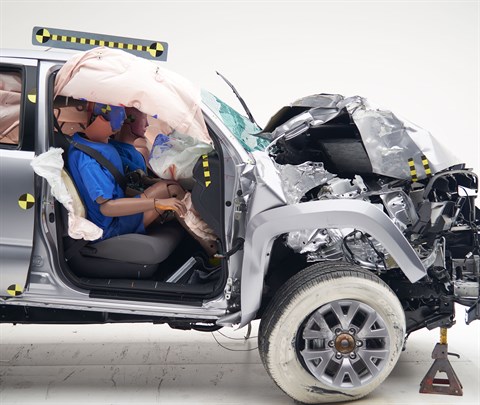
The dummy's position in relation to the door frame and dashboard after the crash test indicates that the passenger’s survival space was maintained well.
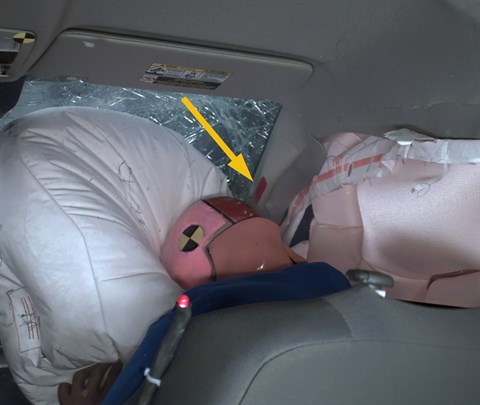
The frontal and side curtain airbags worked reasonably well together, but smeared greasepaint shows where the rear of the dummy's head hit the protruding A-pillar grab handle.

Although intrusion overall into the passenger's space was low, the unusual intrusion pattern of the footwell contributed to a likely risk of injury to the right lower leg and a moderate risk to the right foot.
Moderate overlap front: original test
Rating applies to 2016-23 models
Tested vehicle: 2016 Toyota Tacoma SR5 Double Cab 4wd
The Toyota Tacoma Double Cab was re-engineered and restyled for the 2016 model year. Moderate overlap frontal ratings are assigned by the Institute based on a test conducted by Toyota.
| Evaluation criteria | Rating |
|---|---|
| Overall evaluation | |
| Structure and safety cage | |
| Driver injury measures | |
| Head/neck | |
| Chest | |
| Leg/foot, left | |
| Leg/foot, right | |
| Driver restraints and dummy kinematics | |
Side: original test
Rating applies to 2016-23 models
Tested vehicle: 2016 Toyota Tacoma SR5 Double Cab 4wd
The Toyota Tacoma Double Cab was re-engineered and restyled for the 2016 model year. Side ratings are assigned by the Institute based on a test conducted by Toyota.
| Evaluation criteria | Rating |
|---|---|
| Overall evaluation | |
| Structure and safety cage | |
| Driver injury measures | |
| Head/neck | |
| Torso | |
| Pelvis/leg | |
| Driver head protection | |
| Rear passenger injury measures | |
| Head/neck | |
| Torso | |
| Pelvis/leg | |
| Rear passenger head protection | |
Side: updated test
Rating applies to 2016-23 models
Tested vehicle: 2022 Toyota Tacoma SR Double Cab 4wd
The Toyota Tacoma Double Cab was re-engineered and restyled for the 2016 model year.
| Evaluation criteria | Rating |
|---|---|
| Overall evaluation | |
| Structure and safety cage | |
| Driver injury measures | |
| Head/neck | |
| Torso | |
| Pelvis | |
| Driver head protection | |
| Rear passenger injury measures | |
| Head/neck | |
| Torso | |
| Pelvis | |
| Rear passenger head protection | |

View of the vehicle just after the crash test.
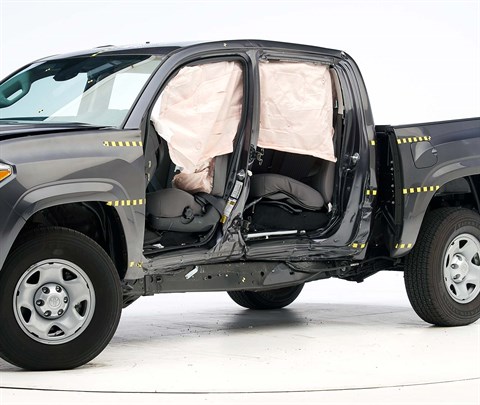
View of the vehicle after the crash with doors removed, showing the side airbags and damage to the occupant compartment.
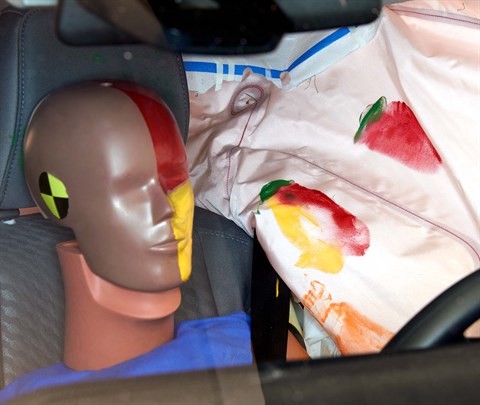
Smeared greasepaint shows where the driver dummy's head was protected from being hit by hard structures by the side airbags.
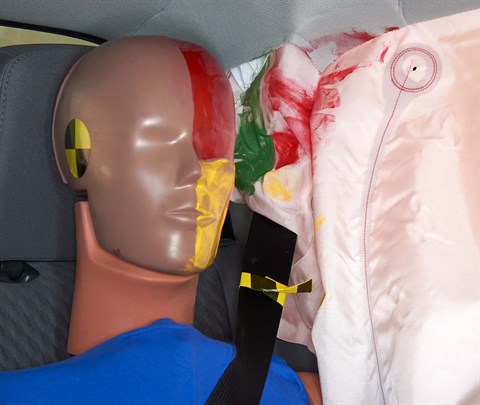
Smeared greasepaint shows where the rear passenger dummy’s head was protected by the side airbag.
Roof strength
Rating applies to 2016-23 models
Tested vehicle: 2017 Toyota Tacoma SR5 Double Cab 2wd
| Overall evaluation | |
|---|---|
| Curb weight | 4,170 lbs |
| Peak force | 17,213 lbs |
| Strength-to-weight ratio | 4.13 |
Head restraints & seats
Seat type: Manual cloth seat
| Overall evaluation | |
|---|---|
| Dynamic rating | |
| Seat/head restraint geometry |
About the head restraint & seat test
Currently, IIHS tests apply only to front seats.
Headlights
Trim level(s)
- All trims
| Evaluation criteria | Rating |
|---|---|
| Low-beam headlight type | Halogen projector |
| High-beam headlight type | Halogen reflector |
| Curve-adaptive? | No |
| High-beam assist? | Yes |
|
Overall rating | |
| Distance at which headlights provide at least 5 lux illumination: | |
Low beams
On the straightaway, visibility was inadequate on both sides of the road. On curves, visibility was inadequate in all 4 tests.
The low beams never exceeded glare limits.
High beams
On the straightaway, visibility was good on the right side of the road and inadequate on the left side. On curves, visibility was fair on the gradual right curve and inadequate on the sharp right and both left curves.
High-beam assist compensates for some limitations of this vehicle's low beams on the straightaway and all 4 curves.
Front crash prevention: vehicle-to-vehicle
Child seat anchors
Rating applies to 2017-23 models
| Evaluation criteria | Rating |
|---|---|
| Overall evaluation | |
| Vehicle trim | SR5 |
| Seat type | cloth |
This vehicle has 2 rear seating positions with complete child seat attachment (LATCH) hardware.
It has 1 additional seating position with a tether anchor only.
| Evaluation criteria | Rating |
|---|---|
| Overall evaluation | |
| Vehicle trim | SR5 |
| Seat type | cloth |
| Rating icon | Rating |
|---|---|
| G | Good |
| A | Acceptable |
| M | Marginal |
| P | Poor |
| Seating positions that rely on borrowed lower anchors or have only a tether anchor available are not rated. | |
thether anchor symbol | Tether anchor |
lower anchor symbol | Lower anchors |
| Lower anchor(s) can be borrowed from adjacent positions(s) | |
| No hardware available |
Details by seating position
| Position | Rating |
|---|---|
| 1 | |
| Tether anchor | |
| hard-to-find location | |
| other hardware could be confused for anchor | |
| Lower anchors | |
| too deep in seat | |
| not too much force needed to attach | |
| easy to maneuver around anchors | |
| 2 | |
| Tether anchor | |
| hard-to-find location | |
| other hardware could be confused for anchor | |
| Lower anchors | |
| none available | |
| 3 | |
| Tether anchor | |
| hard-to-find location | |
| other hardware could be confused for anchor | |
| Lower anchors | |
| too deep in seat | |
| not too much force needed to attach | |
| easy to maneuver around anchors |
